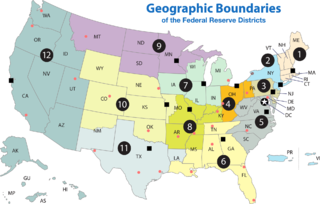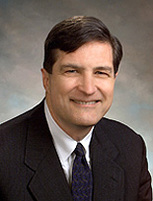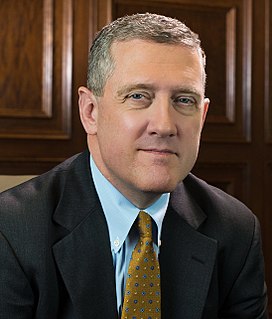Related Research Articles

The Federal Reserve System is the central banking system of the United States of America. It was created on December 23, 1913, with the enactment of the Federal Reserve Act, after a series of financial panics led to the desire for central control of the monetary system in order to alleviate financial crises. Over the years, events such as the Great Depression in the 1930s and the Great Recession during the 2000s have led to the expansion of the roles and responsibilities of the Federal Reserve System.

The Federal Reserve Act was passed by the 63rd United States Congress and signed into law by President Woodrow Wilson on December 23, 1913. The law created the Federal Reserve System, the central banking system of the United States.

A Federal Reserve Bank is a regional bank of the Federal Reserve System, the central banking system of the United States. There are twelve in total, one for each of the twelve Federal Reserve Districts that were created by the Federal Reserve Act of 1913. The banks are jointly responsible for implementing the monetary policy set forth by the Federal Open Market Committee, and are divided as follows:
The Federal Open Market Committee (FOMC), a committee within the Federal Reserve System, is charged under United States law with overseeing the nation's open market operations. This Federal Reserve committee makes key decisions about interest rates and the growth of the United States money supply. Under the terms of the original Federal Reserve Act, each of the Federal Reserve banks was authorized to buy and sell in the open market bonds and short term obligations of the United States Government, bank acceptances, cable transfers, and bills of exchange. Hence, the reserve banks were at times bidding against each other in the open market. In 1922, an informal committee was established to execute purchases and sales. The Banking Act of 1933 formed an official FOMC.

George William Miller served as the 65th United States Secretary of the Treasury under President Carter from August 6, 1979 to January 20, 1981. He previously served as the 11th Chairman of the Federal Reserve, where he began service on March 8, 1978.

William McChesney Martin Jr. was the ninth and longest-serving Chairman of the United States Federal Reserve Bank, serving from April 2, 1951, to January 31, 1970, under five presidents. Martin, who once considered becoming a Presbyterian minister, was described by a Washington journalist as "the happy Puritan".

In the United States, the federal funds rate is the interest rate at which depository institutions lend reserve balances to other depository institutions overnight on an uncollateralized basis. Reserve balances are amounts held at the Federal Reserve to maintain depository institutions' reserve requirements. Institutions with surplus balances in their accounts lend those balances to institutions in need of larger balances. The federal funds rate is an important benchmark in financial markets.

The Federal Reserve System has faced various criticisms since it was authorized in 1913. Nobel laureate economist Milton Friedman and his fellow monetarist Anna Schwartz criticized the Fed's response to the Wall Street Crash of 1929 arguing that it greatly exacerbated the Great Depression. More recent prominent critics include former Congressman Ron Paul.

The Federal Reserve Bank of St. Louis is one of 12 regional Reserve Banks that, along with the Board of Governors in Washington, D.C., make up the United States' central bank. Missouri is the only state to have two main Federal Reserve Banks. Located in downtown St. Louis, the St. Louis Fed is the headquarters of the Eighth Federal Reserve District, which includes the state of Arkansas and portions of Illinois, Indiana, Kentucky, Mississippi, the eastern half of Missouri and West Tennessee. It has branches in Little Rock, Louisville and Memphis. Its building, at 411 Locust Street, was designed by St. Louis firm Mauran, Russell & Crowell in 1924. The Eighth District serves as a center for local, national and global economic research, and provides the following services: supervisory and regulatory services to state-member banks and bank holding companies; cash and coin-handling for the District and beyond; economic education; and community development resources.

The Federal Reserve Bank of Chicago is one of twelve regional Reserve Banks that, along with the Board of Governors in Washington, D.C., make up the nation's central bank. The Chicago Reserve Bank serves the Seventh Federal Reserve District, which encompasses the northern portions of Illinois and Indiana, southern Wisconsin, the Lower Peninsula of Michigan, and the state of Iowa. In addition to participation in the formulation of monetary policy, each Reserve Bank supervises member banks and bank holding companies, provides financial services to depository institutions and the U.S. government, and monitors economic conditions in its District.

The Federal Reserve Bank of Atlanta,, is the sixth district of the 12 Federal Reserve Banks of the United States and is headquartered in midtown Atlanta, Georgia.

Kevin Maxwell Warsh, is an American academic, financier, and former government official. During and in the aftermath of the 2008 financial crisis, Warsh was a governor of the Federal Reserve System, and acted as the central bank's primary liaison to Wall Street and served as the Federal Reserve's representative to the Group of Twenty (G-20) and as the Board's emissary to the emerging and advanced economies in Asia. Prior, Warsh served as Special Assistant to the President for Economic Policy and Executive Secretary of the White House National Economic Council. He is the Shepard Family Distinguished Visiting Fellow in Economics at Stanford University's Hoover Institution, a scholar and lecturer at the Stanford Graduate School of Business, a member of the Group of Thirty, a member of the Panel of Economic Advisers of the Congressional Budget Office, and a former steering committee member of the Bilderberg Group. He has conducted research in the field of economics and finance, and has advised several private and public companies.

Jeffrey M. Lacker is an American economist and was president of the Federal Reserve Bank of Richmond until April 4, 2017. He is now a Distinguished Professor in the Department of Economics at the Virginia Commonwealth University School of Business in Richmond, Virginia.

The College National Fed Challenge is an annual team competition for undergraduate college students inspired by the working of the Federal Open Market Committee. The competition is intended to encourage students to learn more about the U.S. macro economy, the Federal Reserve System and the implementation of monetary policy. The College Fed Challenge also aims at promoting interest in economics and finance as subjects for advanced study and as the basis for a career.

This is a list of historical rate actions by the United States Federal Open Market Committee (FOMC). The FOMC controls the supply of credit to banks and the sale of treasury securities. The Federal Open Market Committee meets every two months during the fiscal year. At scheduled meetings, the FOMC meets and makes any changes it sees as necessary, notably to the federal funds rate and the discount rate. The committee may also take actions with a less firm target, such as an increasing liquidity by the sale of a set amount of Treasury bonds, or affecting the price of currencies both foreign and domestic by selling dollar reserves. Jerome Powell is the current chairperson of the Federal Reserve and the FOMC.

James Brian Bullard is the chief executive officer and 12th president of the Federal Reserve Bank of St. Louis, positions he has held since 2008. He is currently serving a term that began on March 1, 2016. In 2014, he was named the 7th most influential economist in the world in terms of media influence.

The Federal Reserve Bank of Richmond Baltimore Branch Office is one of the two Federal Reserve Bank of Richmond branch offices. The Federal Reserve Bank of Richmond's Baltimore Branch is an operational and regional center for Maryland, the metropolitan Washington D.C. area, Northern Virginia, and northeastern West Virginia. The Baltimore branch is part of the Fifth District and has the code E5. It supports Check 21 operations, supplies coin and currency to financial institutions and works to maintain stability in the financial sector throughout the Fifth District and also works with local elected officials and non-profit organizations to support fair housing initiatives throughout the Fifth District. The Baltimore branch was founded in March 1918 and is currently headed by William R. Roberts.

The Structure of the Federal Reserve System is unique among central banks, with both public and private aspects. It is described as "independent within the government" rather than "independent of government".
In monetary policy of the United States, the term Fedspeak is what Alan Blinder called "a turgid dialect of English" used by Federal Reserve Board chairmen in making wordy, vague, and ambiguous statements. The strategy, which was used most prominently by Alan Greenspan, was used to prevent financial markets from overreacting to the chairman's remarks. The coinage is an intentional parallel to Newspeak of Nineteen Eighty-Four, a novel by George Orwell.

J. Alfred Broaddus Jr. was the sixth president of the Federal Reserve Bank of Richmond, headquarters of the Fifth District of the Federal Reserve System serving the District of Columbia, Maryland, North Carolina, South Carolina, Virginia, and most of West Virginia with the exception of the Northern Panhandle.
References
- ↑ "Central High Team Takes Top Honors in National "Fed Challenge"", Federal Reserve Bank of St. Louis press release dated May 22, 2007. Accessed August 5, 2007. "A team of students from Little Rock Central High School won first place in the Fed Challenge, a national economics competition sponsored by the Federal Reserve System."
- ↑ Severn School Wins the Fed Challenge National Championship, Federal Reserve Bank of Richmond News Release, dated May 2, 2006.